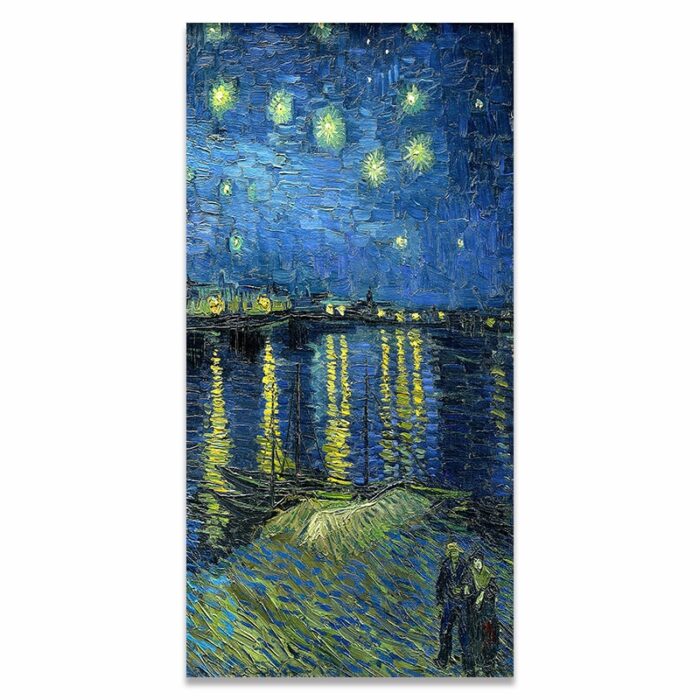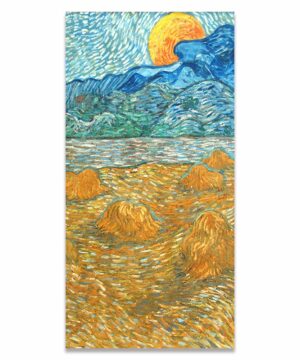Vincent van Gogh painted a wide range of different subject matter during his short career as an artist. He had a strong affinity toward motives of nature, best known for his paintings of sunflowers and wheat fields. The development of his unique style applying emphatic brush strokes and the emotive use of colour can best be seen by comparing motives and themes he revisited time and again. Among those motives are streetlights, stars, and light effects in general, as can be seen in a series of starry night images including “Café Terrace at Night” and also “Starry Night Over the Rhône”, a landscape paintingLandscape painting focuses on the depiction of natural scenery such as mountains, valleys, trees, rivers, and forests. It has been a significant genre in art history, evolving through various styles and periods. Landscape painting captures the beauty of the natural world and often reflects the cultural and philosophical views of the time. JMW Turner, Calais Pier, 1801 Historical Context Landscape More which he completed in spring 1888.
Where is the picture “Starry Night Over the Rhône” today?
The original picture of “Starry Night Over the Rhône”, also abbreviated to “Starry Night” was first exhibited in 1889 at Paris’ annual exhibition of the Société des Artistes Indépendants. Today it is shown as part of the permanent collection in the Musée d’Orsay in Paris.
What’s in it?
Van Gogh depicts a view is from the banks of the river Rhône onto an iron bridge connecting Arles to the suburb of Trinquetaille. Using colours of strong contrast, the picture emphasizes the darkness of the night and the effects of light – both natural in the energetic twinkling of the stars and the artificial illumination of gas lamps. The glimmering effects are further accentuated by employing energetic brushstrokes, which have become van Gogh’s signature style by this time. Although infused with vibrant energy, the overall appearance of the scene is serene and calm. Only two people, a silent couple in the foreground, are witnesses of the panorama.
What’s the context?
Van Gogh Facts:
Van Gogh painted his landscape paintingLandscape painting focuses on the depiction of natural scenery such as mountains, valleys, trees, rivers, and forests. It has been a significant genre in art history, evolving through various styles and periods. Landscape painting captures the beauty of the natural world and often reflects the cultural and philosophical views of the time. JMW Turner, Calais Pier, 1801 Historical Context Landscape More “Starry Night” in 1888 after he had arrived in Arles in February. He was highly productive in the following months and painted numerous landscape pictures around Arles, in which he further developed his expressive style characterized by dynamic brushstrokes, strong contrasts, and bold colours. As can be deducted from several of his letters, van Gogh was preoccupied with the representation of “light effects”, writing: “I need a starry night with cypresses or maybe above a field of ripe wheat.”, or “But when shall I ever paint the Starry Sky, this paintingPainting is a fundamental form of visual art that has been practiced for thousands of years. It involves applying pigment to a surface such as canvas, paper, or a wall. Painting can be explored through various styles, techniques, and mediums, each offering unique possibilities for expression and creativity. Historical Background • Ancient Beginnings: The history of painting dates back to More that keeps haunting me”.
Chatter and Prattle
- Soon after having painted “Starry Night Over the Rhône”, van Gogh’s mental state rapidly deteriorated. In a feverish confrontation with his fellow artist Paul Gauguin, most likely in a state of psychosis, van Gogh cut off part of his own ear.
- Van Gogh left Arles for treatment in a mental health asylum in nearby Saint-Rémy. While at the facility, van Gogh completed over 150 paintings – one among them being “The Starry Night” – a view through his iron-barred window. Here, similar light effects as in “Starry Night Over the Rhône” are eminent. However, the atmosphere appears much more dramatic and agitated.
- A year later, van Gogh shot himself in a wheat field and succumbed to his injuries.
Recommended Readings:
This article may contain compensated links. Please read Disclaimer for more info. As an Amazon Associate, I earn from qualifying purchases.
Ingo F. Walther et al. (2020): Van Gogh. The Complete Paintings
Vincent Van GoghVincent van Gogh (1853 – 1890) is one of the renowned Post-Impressionist artists, best known for his striking use of colour, emphatic brushwork, and contoured forms. As a son of a pastor, the Dutch artist war brought up in a religious and cultured atmosphere. After working unsuccessfully as a clerk at a bookstore, as a salesman, and as a preacher More (2020): The Letters of Vincent Van Gogh
Martin Gayford (2008): The Yellow House: Van Gogh, Gauguin, and Nine Turbulent Weeks in Provence
Steven Naifeh et al. (2012): Van Gogh: The Life (RANDOM HOUSE)
Steven Naifeh (2021): Van Gogh and the Artists He Loved













Reviews
There are no reviews yet.